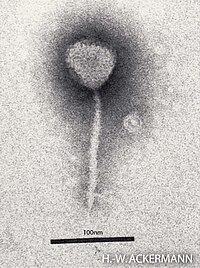
Photo from wikipedia
Bacteriophage N15 is the first virus known to deliver linear prophage into Escherichia coli. During its lysogenic cycle, N15 protelomerase (TelN) resolves its telomerase occupancy site (tos) into hairpin telomeres.… Click to show full abstract
Bacteriophage N15 is the first virus known to deliver linear prophage into Escherichia coli. During its lysogenic cycle, N15 protelomerase (TelN) resolves its telomerase occupancy site (tos) into hairpin telomeres. This protects the N15 prophage from bacterial exonuclease degradation, enabling it to stably replicate as a linear plasmid in E. coli. Interestingly, purely proteinaceous TelN can retain phage DNA linearization and hairpin formation without involving host- or phage-derived intermediates or cofactors in the heterologous environment. This unique feature has led to the advent of synthetic linear DNA vector systems derived from the TelN-tos module for the genetic engineering of bacterial and mammalian cells. This review will focus on the development and advantages of N15-based novel cloning and expression vectors in the bacterial and mammalian environments. To date, N15 is the most widely exploited molecular tool for the development of linear vector systems, especially the production of therapeutically useful miniDNA vectors without a bacterial backbone. Compared to typical circular plasmids, linear N15-based plasmids display remarkable cloning fidelity in propagating unstable repetitive DNA sequences and large genomic fragments. Additionally, TelN-linearized vectors with the relevant origin of replication can replicate extrachromosomally and retain transgenes functionality in bacterial and mammalian cells without compromising host cell viability. Currently, this DNA linearization system has shown robust results in the development of gene delivery vehicles, DNA vaccines and engineering mammalian cells against infectious diseases or cancers, highlighting its multifaceted importance in genetic studies and gene medicine.
Journal Title: ACS synthetic biology
Year Published: 2023
Link to full text (if available)
Share on Social Media: Sign Up to like & get
recommendations!